ASUS UX31A: Putting the Ultra in Ultrabooks
by Jarred Walton on August 28, 2012 9:00 AM EST- Posted in
- Laptops
- Intel
- Asus
- Ivy Bridge
- Zenbook Prime
- Ultrabook
ASUS UX31A: Gaming Performance
First, let’s get this out of the way: this page is only for those who are interested/curious about gaming potential. If you’ve seen any of our previous looks at Intel’s HD 4000 GPU performance, you should already know what to expect. Intel can now run DX11 titles, but in practice you’ll need to use a lower resolution (e.g. the ever-so-popular 1366x768, or even 1280x720) with low to medium detail settings. Even then, some titles are simply too demanding for HD 4000. If you can wait another year, Haswell is supposed to double down on HD 4000 performance, but the waiting game isn’t very fun to play. We’re only going to show gaming results at our Value (~Medium 1366x768) settings, but if you want to see what happens at higher quality settings we’ve included Mainstream (~High 1600x900) results in Mobile Bench.
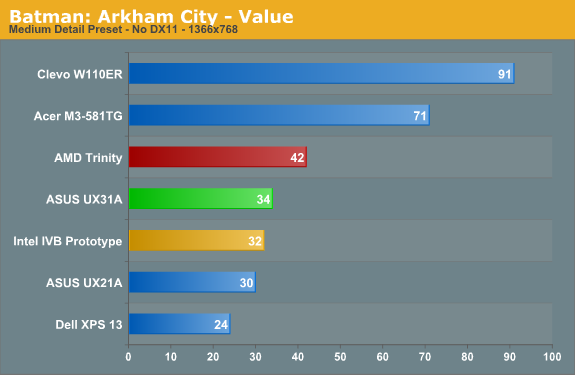

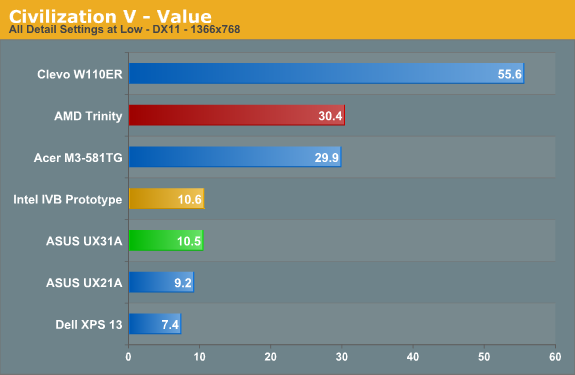
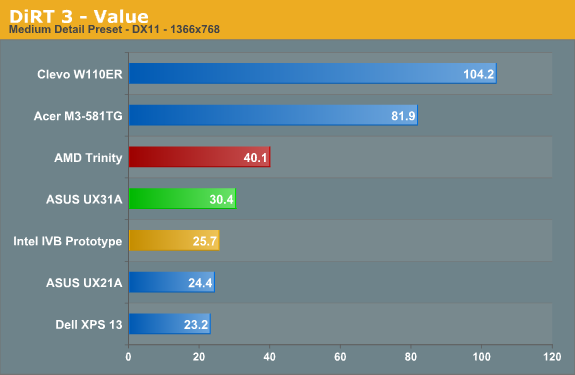
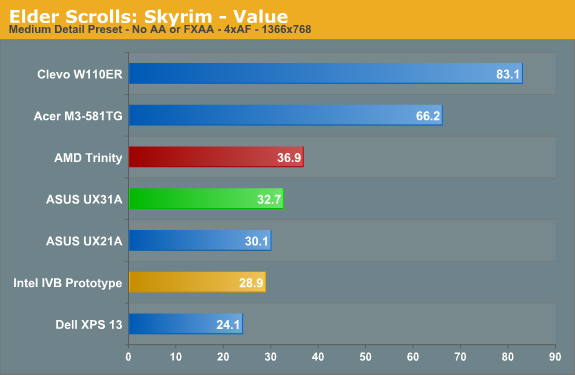
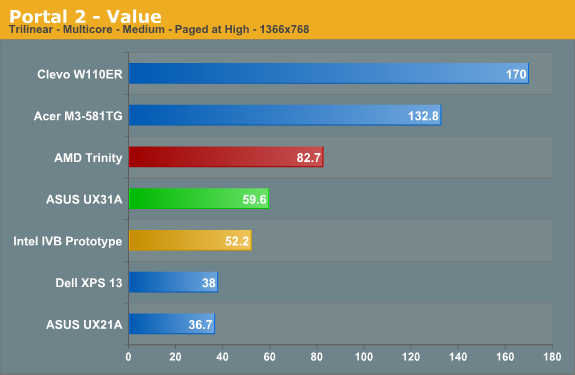
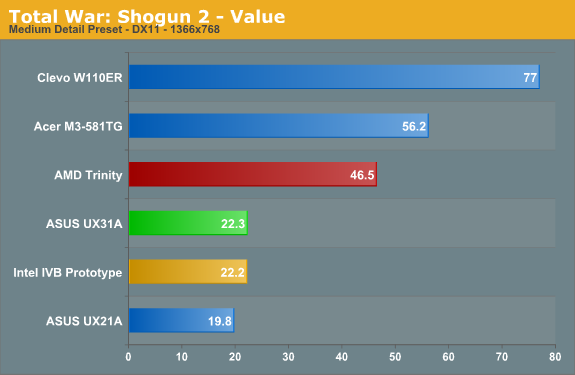
Much like the prototype IVB Ultrabook, the UX31A proves to be somewhat less capable than the standard voltage IVB parts when it comes to gaming. We still manage to pull playable frame rates in Batman, DiRT 3, Portal 2, and Skyrim, but even with average frame rates above 30FPS you’ll still see occasional dips into the low 20s or even the teens. At the native 1080p resolution, only Portal 2 is able to stay above 30FPS average, but I don’t think anyone really expected 1080p gaming to be a priority. In short, it’s possible to play some games on an Ultrabook without a dedicated GPU, but the experience won’t be all that great in many recent titles. AMD's Trinity on the other hand puts in a very respectible showing, with the understanding that the Acer M3 (and the newer M5) pretty much beat the A10 on all fronts.
At this point, we probably won't bother returning to look at Ultrabook gaming performance until something changes on the IGP (other than for discrete GPU models). We've exhaustively tested IVB ULV twice now, and the results are largely the same, other than a few minor differences that we can chalk up to drivers. If you want to know how Core i5/i7 ULV Ivy Bridge perform, the results above should tell you everything you need to know.










106 Comments
View All Comments
nerd1 - Tuesday, August 28, 2012 - link
I'd like to see some quality review of sammy's series 9 laptop. So far I have only seen crappy amateurish reviews so far (*ahem* engadget *ahem* theverge *ahem*) and I think it is one of two best ultrabook options out there with 1600*900 matte PLS display.Toshio - Tuesday, August 28, 2012 - link
notebookreview.com has a decent review:http://www.notebookreview.com/default.asp?newsID=6...
also they reviewed the 15" version, pretty interesting:
http://www.notebookreview.com/default.asp?newsID=6...
an Anandtech review would be pretty good whatsoever ;)
nerd1 - Tuesday, August 28, 2012 - link
That's old gen model with sandby bridge. Engadget review reports 7 hrs of battery life with new laptop - I'd like 'proper' review here. ;]JohnMD1022 - Tuesday, August 28, 2012 - link
PC Decrapifierhttp://pcdecrapifier.com/
ajp_anton - Tuesday, August 28, 2012 - link
"ASUS did provide an updated Realtek driver that seemed to improve the audio quality slightly"Does this mean ASUS has tweaked the drivers themselves, or that it's just a newer version and I don't lose anything by upgrading from Realtek's website myself sometime in the future?
JarredWalton - Tuesday, August 28, 2012 - link
It looks like stock Realtek, but I could be wrong.geniekid - Tuesday, August 28, 2012 - link
Let's not forget the predecessors to these new fancy ultrabooks - the Asus UL series! My laptop at the moment is the Asus UL80Vt and even with its G210M, I can still run TF2, Civ 5, Diablo 3 and Guild Wars 2 on this machine, albeit at low quality and 1366x768 resolution. And this is a 3 year old laptop that cost me $850.These days, I won't be happy without a 650M and 900p resolution on a 14" screen, but the UL80Vt will always have a warm spot in my heart.
falc0ne - Tuesday, August 28, 2012 - link
I really don't see all the fuzz about ASUS.I had quite a few issues with ASUS products, most recent being with a brand new laptop featuring Sandy Bridge platform with core i7 processor that came with the hard drive DOA. I've only seen this happening with Acer or other OEMs that sell 'value' products. But ASUS is charging you premium prices. I just see them charging for premium quality but that quality just isn't there...
From my past experiences I have 2 other desktops that I built and the motherboards failed. One failed in 3 months, the other 9-11 months. I have to mention the laptop the came DOA was in the range of $1600 and the latest motherboard that failed in the $150 price range - so not cheap ones at all.
Anyone else had issues with their products?
Roland00Address - Tuesday, August 28, 2012 - link
Why can't AMD make an ultrathin that is about $500 dollars that uses the a6 or a10 ulvIt would be so easy for AMD to get an OEM to actually build an ultrathin that is cheap and actually good just by swapping out a few parts.
Use a standard 11.6" netbook case. Many oems have cases that can take 17w processors in this form factor that are cheap remember the e series of amd processors have the same tdp as the a6 ulv. The faster celeron and pentium ulv dual cores also use 17w for tdp. For example hm dm1, Sony YB, Sony E11, my favorite the Lenovo Thinkpad x130, Lenovo x131, etc and the Acer Aspire One 756 (they finally got rid of the floating island crap and are now use chicklet). I am going to be talking more about the Acer Aspire One 756 below
Place at least 4 GBs of ram in the computer but it has to be in dual channel mode. If you can't do 2x2GBs then 6 GBs (1x2gb+1x4gb) or 8 GBs. Note all the models I listed above have two memory slots.
At least a 320gb hard drive or a 128 gb ssd. Note all the models I listed above use standard harddrives though some are limited to 7mm high models. The cheapest 320gb 7mm hard drives on the open market cost about $55 to 60, a samsung 830 128gb 7mm height ssd goes for about $100. So lets say $40 dollars extra for ssd.
A 1366x768 screen, it doesn't need to have a high rest just good viewing angles. Currently TN panels are all you can find in the 11.6 form factor, but with the rise of tablets and windows 8 tablets coming out this fall I won't be suprised we will see 11.6 ips screens starting to appear. To put it in comparison a 11.6 inch screen with 768 pixels height in the 16x9 ratio is 10.11" by 5.68" the ipad 2 4x3 ratio with 768 pixels 7.75" by 5.83." Chinese OEMs have complete ips tablets in the 9.7" form factor going for $120 so the screen cost isn't exhorborant if someone is actually making that size and form factor. Problem is no one is currently making this form factor but I hope for windows 8 to change all this.
-------
To put it in comparison. Acer has a Acer Aspire One 756 with a celeron dual core, 4gbs of ram, and 500gb hard drive, with 7 home premium going for $349 final price on the open market. (Full model is AO756-2808-US) It weights 3.04 lbs with its 4 cell battery and is 1.1" inch tall.
AMD has $150 dollars to play with (if they can convince acer to build it) to put the a6 ulv dual core and place an extra stick of memory and suddenly they are in the $500 dollar price market where people will seriously consider buying an amd ultra portable. I know the a6 ulv price that oems pay is nowhere near the difference of a celeron price+$150 since the tray price (which is not neccessary what acer pays intel) of the 3rd generation ultrabook i5 ulv is $225.00. (Intel and AMD don't publish tray prices for their celeron ulv or the a6 4455m)
So why hasn't amd been able to convince anyone to do this? There are only two computer I have seen with the a6 4455m is the 15.6" hp sleekbook. I personally consider this computer fail for it is a 15.6" that weights as much as a 14" and still costs over $600 dollars. Why would someone pay that much, for an item that is so big, yet the have to go with the sacrifices of a ulv processor.
There is also a samsung series 5 13.3" that uses the a6 4455m but its going price is $660 to $700. This computer is more my style but when the 3rd generation i5 version is going for the same price $660 to 700 why the hell would you go with the slower AMD option? (To top it off the Samsung uses the 500gb seagate hybrid drive while the AMD system does not.)
nevertell - Tuesday, August 28, 2012 - link
I'd love to see an article about an ultraportable or atleast a laptop with a 17w i7 dualcore with an express card slot with an external GPU. I know that there is some guerilla hardware involved in these setups and these are the exception, not the rule, but I've always entertained the idea of a portable that doubles as a desktop once you put it in a dock.Ultrabooks by themselves are never going to get further than they are now, since you don't need an i5 to browse the web, but to do anything more, the form factor is sort of limiting the machine. I don't really understand the fuss behind ultrabooks, if intel isn't making it a rule for them to have thunderbolt, as that WOULD solve most of the problems at this point in time I have with ultrabooks. Whilst you wouldn't have a special dock for extra cooling to exceed the thermal limits of the platform, you would at least have a way to connect an external GPU, high speed and high capacity storage and other peripherals.
At this point in time I don't really need a modern ultrabook, I already have one from the 2009- the X200s. It's keyboard is far superior to any of the chiclet keyboards that are trending nowadays, I can easily get 5 hours of usage on my 9 cell battery on wifi (7 and more if I am just writing stuff) and it still is easy to carry around. The only thing I would love to have is a unified high speed interface to connect peripheral devices as the express card slot is too slow. Or, in other words, THUNDERBOLT! Since these ultrabooks have hardware limitations. I can't really do any serious work on them anyway, so why would I need more processing power than I have at the moment from a ultra low voltage Core 2 processor, if it is sufficient enough for the same usage model the ultrabook (as it is now implemented) is intended.
TL/DR version- if there is no thunderbolt, then even a 4 year old ultraportable would suffice to do the ultrabooks job as the form factor and hardware of ultrabooks limit their usage model.